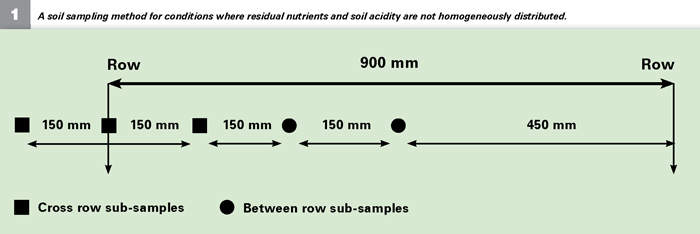July 2021
| PIETMAN BOTHA, INDEPENDENT AGRI- CULTURAL CONSULTANT |
 |
Soil sampling is the basis of all optimal fertiliser and lime recommendations. The main objective of the liming or fertiliser programme is to correct the soil chemical restriction in the most economically viable manner to produce maximum output.
With soil potential, soil sampling and laboratory analyses for nutrients results known it is possible to determine the optimal liming or fertiliser programme. If soil sampling is not done correctly the results will not reflect the status in the soil and then the optimal yield will not be reached.
Because of the band placing of fertiliser and because cultivation practices usually do not mix the fertiliser effectively throughout the soil, plant nutrients are usually not distributed evenly throughout the soil. It is thus vital to take care that soil samples are taken correctly.
There is more than one method to take soil samples and it is important to discuss this with the fertiliser representative before taking the samples.
Method 1 is recommended where residual nutrients and soil acidity are distributed homogeneously, for example in uncultivated soils or where residual bands have been removed by tillage not ploughing. Normally this method will not be used.
For less than 50 ha at random 20 to 40 topsoil (0 - 150 mm) sub-samples are needed. Make use of a 75 mm diameter soil auger. Five sub-samples for the deeper increments (150 mm - 300 mm, and 300 mm - 600 mm) that are taken at random over the same area is sufficient. If nitrogen analyses are required, separate but single samples taken from 0 - 600 mm depth, should be taken.
Method 2 is used most of the times and is recommended for conditions where residual nutrients and soil acidity are not homogeneously distributed. This will normally be after harvesting and before the first tillage operation is done.
This method is applicable to most grain producing areas, since most fertilisers are banded at planting and are usually followed by an N fertiliser top-dressing. Orders for especially lime should be placed well in advance of the first tillage operation. The fertiliser order can be placed later but remember first order will receive first delivery. (Method 2 is published in the Maize Information Guide).
Representative samples of a 300 mm wide band over maize rows are analysed separately from between-row samples, as illustrated for a row width of 900 mm in Figure 1.

In total 5 samples are taken three cross the row and two within the row.
Cross row sub-samples (■): The three samples are taken across the row so that the fertiliser band can be sampled. The three samples represent a band of ±300 mm.
Between row sub-samples (●): Two samples are taken in this area. One soil sample is taken exactly in the middle of two rows (450 mm from the row for a row width of 900 mm). A second soil sample is taken exactly in the middle of the cross row sub-sample (■) and the between row sub-sample (●) – 300 mm from the plant row for a row width of 900 mm.
Make sure that the same tool is used to take the sample. Depth increments are the same as for the previous method, namely 0 - 150 mm, 150 mm - 300 mm and 300 mm - 600 mm. The sampling procedure is repeated five times per 50 ha soil unit. The five 0 - 150 mm samples are mixed thoroughly and one subsample taken from the mixture for analysis. The same procedure is followed for the 150 mm - 300 mm and 300 mm - 600 mm samples.
Soil samples must be handled correctly and should be air-dried or frozen if N analysis is required and samples cannot be delivered to the laboratory within 24 hours. Samples should in all instances not be exposed to direct sunlight. A soil mass of between 500 g and 1 kg is required for each sample for analysis.
For more information contact Pietman Botha at 082 759 2991 or your local fertiliser representative.
Methods to take soil samples
The Fertiliser Handbook gives excellent guidelines on methods to take soil samples. Some important aspects are highlighted here:
Publication: July 2021
Section: Pula/Imvula